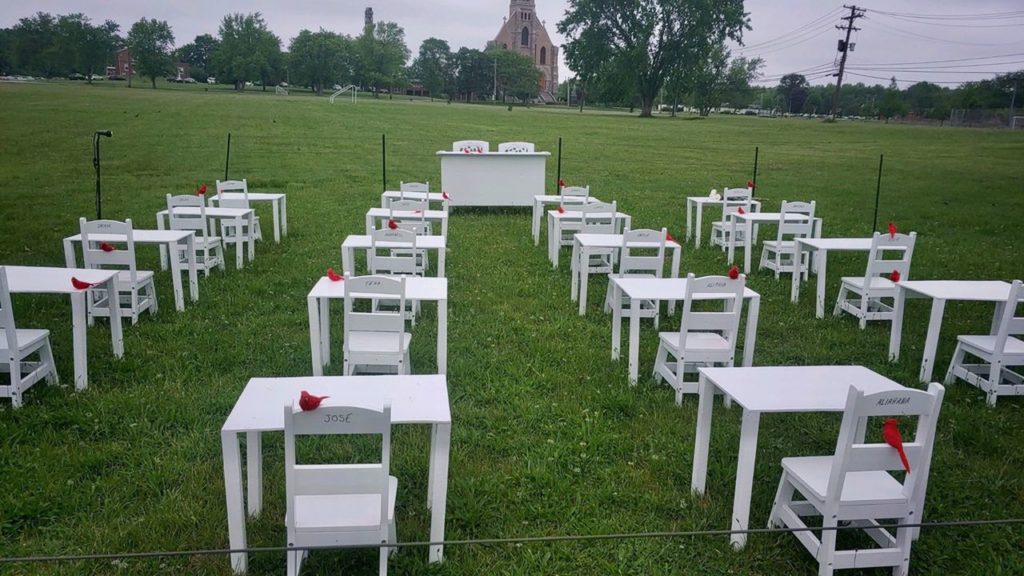Fourth Grade

I am thinking about fourth grade.
Ten years old.
Halfway through growing up.
Neither child nor teenager.
Not the innocence of second grade.
Not as articulate as high school.
How will they survive fourth grade?
I think about the Latinx names we are hearing. When I taught about the West, I remember that south and west of San Antonio was a cultural area closely tied to Mexico, which borders it. It was not free from colonialism. This week NPR featured the history of Robb, a “Mexican school” in Uvalde and segregated until the 1960s. George Garza, a Mexican-American, was hired as teacher in 1965. He presented the concerns of the Spanish-speaking parents to the principal, and when his contract was not renewed in 1970, the community led a walkout. It’s a compelling narrative of years of struggle and final success, affected forever by the tragic narrative of two weeks ago.
If the article by Rick Rojas in the New York Times were in the Catholic press, I would not have been surprised. I hope you can read it. He describes Sacred Heart Church in Uvalde, which we keep hearing about as the locus of funerals. It’s the center of that Mexican-American community, the place where people spontaneously gather.
Church leadership showed up in Ulvalde. Rojas reports that Archbishop Gustavo García-Siller of San Antonio “said that Sacred Heart was meant to be a gathering place not only for practicing Catholics, especially now…’People want to pray…People want to help. All the community beyond the parish is so connected.” These words are much more compelling than the official statements that he and other bishops and the USCCB issued, Chicago Cardinal Blase Cupich excepted.
Rojas continues, “Still, some families have drifted, pulled by the ascendance of evangelical congregations, dissatisfaction with leaders as the global Roman Catholic church became engulfed in scandal or a broader societal shift away from institutional religion.” I heard a deeply inspiring woman pastor on the PBS NewsHour one evening. There are some funerals at these churches, too.
None of the coverage I saw of President Biden’s visit to Sunday mass raises the question of communion, for which I am immensely grateful. Rojas says, “The pews were crowded as President Biden took his seat in the first row. He did not speak during the service. He knelt, made the sign of the cross and prayed along with the rest of the congregation — just another soul searching for unity and clarity who walked through the doors of Sacred Heart.”
Kevin Clarke in America highlighted the work of lay-led Catholic Charities of San Antonio. CEO J. Antonio Fernandez has established programs at Sacred Heart like helping with visas for family members from Mexico and arranging home visits by counselors to those traumatized by the press about their grief. They’ve made a long-term commitment to the community.
Dan Horan in NCR has a fascinating riff on the etymology of the word “religion” and uses it to transition from Uvalde to guns as a religion in the US, and then to Archbishop Cordileone and communion. Horan says, “When church leaders like Cordileone act in the way that he has…he not only commits pastoral malpractice, but also reveals his true religion.” He asks, “To what or whom does Cordileone bind himself? What takes priority in his decision-making and administrative choices?”
Josephine Garrett is a recently-professed black Sister of Nazareth, and I report that because she goes to a whole other place in an article in America, and asks, “What are some things you can do to protect your mental health as we walk the road to racial justice and peace, while continuing to experience the fruits of racism and white supremacy?”, like the recent shootings. In a podcast with Gloria Purvis, she explores her suggestions:
1. Be intentional about media exposure.
2. Express your feelings in a supportive setting, and name the experience.
3. Make meaningful connections and contributions.
4. Dealing with the naysayer.
Finally, to do some of that work, you might want to listen to an online public dialogue, “After Buffalo, After Uvalde: Broken Hearts, Broken Nation, Faithful Action.” It’s next Wednesday, June 8, 2022, from 12:30 – 1:30 p.m. EDT. Speakers are Sr. Judy Bryon, Archbishop Garcia-Siller, journalist Rhina Guidos, and Fr. Bryan Massingale. You can read about them and register here. It’s sponsored by the Initiative on Catholic Social Thought and Public Life at Georgetown University.

2 Responses
What a haunting image Regina! I had not seen it. There has been some good commentary this week about our addiction to guns and maybe some new calls for action. . When viewed alongside the “Christian” right pro gun, pro individual rights, and anti-choice/pro life rhetoric I keep coming back to the same contradictions. There is no such thing as being pro life and pro gun. It is convenient to talk about freedom and personal rights as long as we are not talking about women’s rights and freedom to control their own bodies. Once again, no discussion of mens co-responsibility for preventing unwanted pregnancies. Alas, we know these are not unrelated issues.
Wow! You have given so many resources — once again, I will be busy. Thank you for mentioning George Garza. I heard his moving story on NPR.